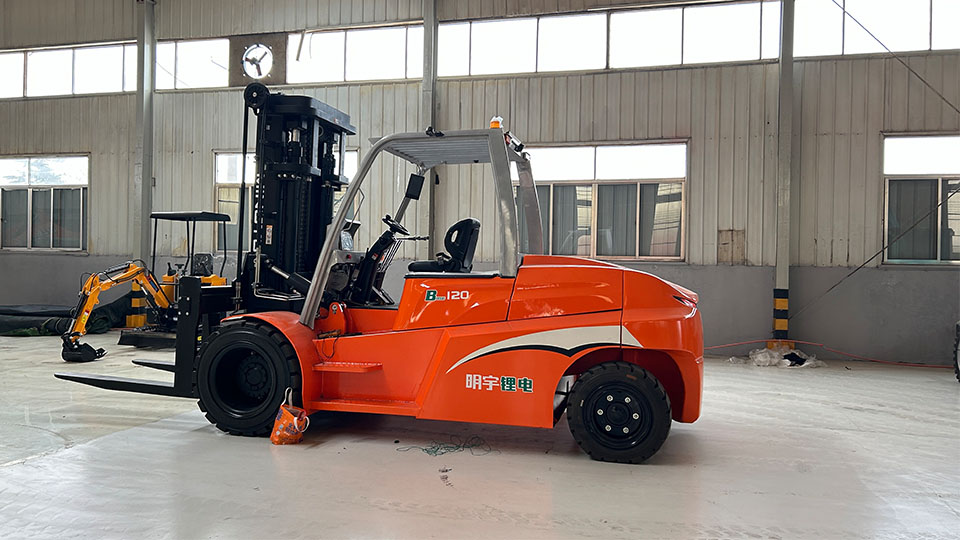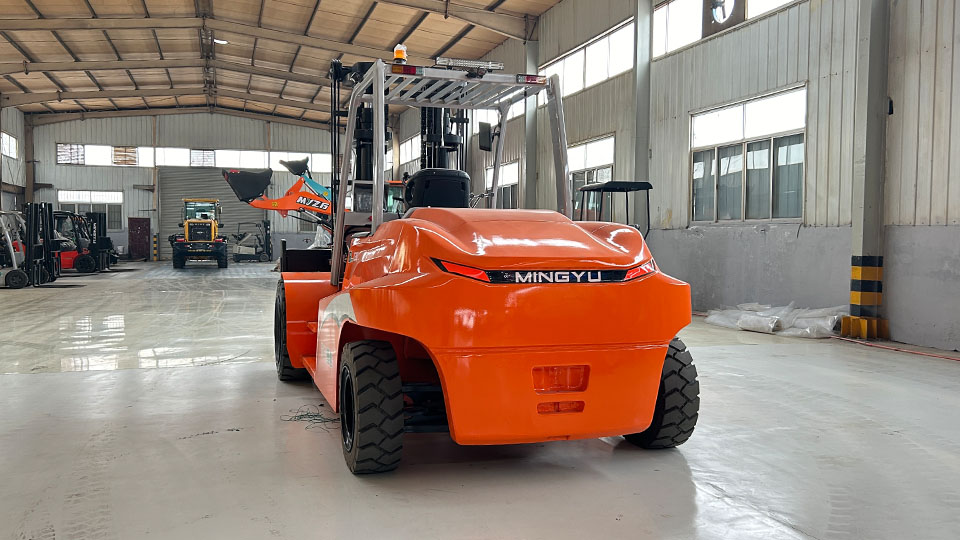
Unstable Ground Conditions: Soft or collapsing ground can cause a wheel to sink, tilting the forklift and potentially leading to a tip-over.
The Immediate Response: What the Operator Must Do

When a forklift begins to tip over, the operator's immediate reaction is critical for their safety. The instinctive urge to jump out is often the most dangerous response. Here's a breakdown of the correct procedures:
Stay Inside the Operator Compartment: This is the most crucial action. The overhead guard (FOPS - Falling Object Protective Structure) is designed to protect the operator within the confines of the compartment in the event of a tip-over. Jumping out exposes the operator to the crushing weight of the falling forklift.
Brace Yourself Firmly: Immediately grip the steering wheel or any other secure handholds firmly. Plant your feet firmly on the floorboard. This helps to keep your body within the protective cage of the operator compartment.
Lean Away from the Direction of the Tip: If the forklift is tipping sideways to the left, lean as far to the right as possible, bracing against the side restraint or seat. If it's tipping forward, lean back firmly against the seat back. This action shifts your body weight within the compartment, offering a degree of counter-balance and staying within the protective structure.
Do Not Attempt to Jump Out: As mentioned before, this is a natural but extremely dangerous reaction. The falling forklift can crush or trap anyone attempting to exit. Remain within the protected zone.
Remain Inside Until the Forklift Comes to a Complete Stop: Once the forklift has come to rest, remain in your braced position until all movement has ceased. Assess the situation carefully before attempting any further action.
Actions for Nearby Personnel
If you witness a forklift tipping over, your immediate actions are also critical to ensure safety:
Warn Others: Immediately shout clear warnings like "Tip-over!" to alert anyone in the vicinity to the danger.
Clear the Area: Quickly move away from the tipping forklift and the immediate surrounding area to avoid being struck by the falling machine or any dislodged materials. Maintain a safe distance until the situation is stable.
Do Not Approach the Tipped Forklift: Resist the urge to immediately rush towards the tipped forklift. The situation may still be unstable, and further movement or attempts to right the machine by untrained individuals can lead to further injury or damage.
Await Trained Responders: Allow trained personnel, such as supervisors, safety officers, and maintenance technicians, to assess the situation and initiate the appropriate recovery procedures.
Post-Incident Procedures: Ensuring Safety and Preventing Recurrence
Once a forklift has tipped over, a systematic approach is essential to ensure the safety of everyone involved, recover the equipment safely, and prevent similar incidents in the future. This involves several key steps:
Secure the Area: Establish a safety perimeter around the tipped forklift to prevent unauthorized access and potential further hazards. Use warning tape or barriers to clearly mark the area.
Assess for Injuries: The immediate priority is to determine if the operator or any nearby personnel have been injured. Provide first aid if necessary and immediately contact emergency medical services for serious injuries. Do not attempt to move an injured person unless absolutely necessary due to immediate danger.
Stabilize the Forklift (If Necessary): If the forklift is in an unstable position after the initial tip-over, trained personnel may need to take steps to further stabilize it before attempting recovery. This might involve using chocks, blocks, or other stabilizing equipment.

Do Not Attempt to Right the Forklift Without Proper Training and Equipment: Righting a tipped forklift is a complex and dangerous operation that requires specialized equipment (such as cranes or other heavy lifting machinery) and personnel trained in safe lifting procedures. Incorrectly attempting to right the forklift can cause further damage to the equipment and pose a significant risk of injury.
Thorough Equipment Inspection: Once the forklift is safely uprighted, a comprehensive inspection by qualified maintenance personnel is mandatory. This inspection should identify any damage to the frame, mast, hydraulic systems, tires, safety devices, and other critical components. The forklift must not be returned to service until all damage has been properly repaired and certified as safe.
Incident Investigation: A thorough investigation into the cause of the tip-over is crucial for identifying contributing factors and implementing corrective actions to prevent future incidents. This investigation should involve:
Gathering Information: Interviewing the operator and any witnesses, reviewing pre-shift inspection logs, analyzing the work environment, and examining any relevant data (e.g., telematics).
Identifying Root Causes: Determining the underlying reasons why the tip-over occurred. This may involve human error (e.g., speeding, improper load handling), environmental factors (e.g., uneven terrain, inadequate lighting), equipment issues (e.g., faulty brakes, overloading due to incorrect capacity rating), or procedural deficiencies (e.g., inadequate training, poorly defined traffic routes).
Developing Corrective Actions: Implementing specific measures to address the identified root causes. This may include retraining operators, modifying work procedures, improving workplace conditions, repairing or replacing equipment, or revising safety protocols.
Review and Update Safety Procedures: The findings of the incident investigation should be used to review and update existing safety procedures and training programs. This ensures that lessons learned from the incident are incorporated into ongoing safety efforts.
Operator Retraining and Re-evaluation: The operator involved in the tip-over should undergo retraining and a re-evaluation of their operating skills and knowledge before being allowed to operate a forklift again. This provides an opportunity to reinforce safe operating practices and address any potential skill deficiencies identified during the investigation.
The Importance of Prevention
While understanding how to respond to a tip-over is critical, the ultimate goal is to prevent such incidents from occurring in the first place. This requires a strong safety culture that emphasizes:
Comprehensive Operator Training: Initial and ongoing training that covers all aspects of safe forklift operation, including stability principles, load handling, workplace hazards, and emergency procedures.
Strict Adherence to Safety Regulations and Procedures: Consistent enforcement of all relevant safety rules, regulations, and site-specific procedures.
Regular Equipment Maintenance: Proactive maintenance programs to ensure that forklifts are in safe operating condition and that any defects are promptly addressed.
Thorough Pre-Shift Inspections: Mandatory pre-shift inspections by operators to identify and report any equipment deficiencies before operation.
Workplace Hazard Assessment and Control: Regularly identifying and mitigating potential hazards in the work environment, such as uneven surfaces, congested areas, and poor lighting.
Proper Load Management Practices: Ensuring that loads are within the forklift's capacity, properly secured, and handled according to established procedures.
Speed Limits and Traffic Management: Implementing and enforcing safe speed limits for forklift operation and establishing clear traffic routes within the workplace.
Continuous Safety Improvement: Fostering a culture of continuous improvement where safety concerns are actively reported, and lessons learned from near misses and incidents are used to enhance safety practices.
Conclusion: Preparedness and Prevention as Cornerstones of Safety
A forklift tip-over is a serious event with the potential for severe injury and significant damage. While the immediate response of the operator to stay within the compartment and brace themselves is paramount, the actions of nearby personnel and the thorough post-incident procedures are equally crucial for ensuring safety and preventing future occurrences. However, the most effective strategy for dealing with forklift tip-overs is prevention. By fostering a strong safety culture, providing comprehensive training, maintaining equipment diligently, and proactively managing workplace hazards, organizations can significantly reduce the risk of these dangerous incidents and ensure a safer working environment for everyone. Understanding the "what to do" in the event of a tip-over is vital, but the ultimate aim should always be to create a workplace where such events are exceedingly rare.
Name: selena
Mobile:+86-13176910558
Tel:+86-0535-2090977
Whatsapp:8613181602336
Email:vip@mingyuforklift.com
Add:Xiaqiu Town, Laizhou, Yantai City, Shandong Province, China